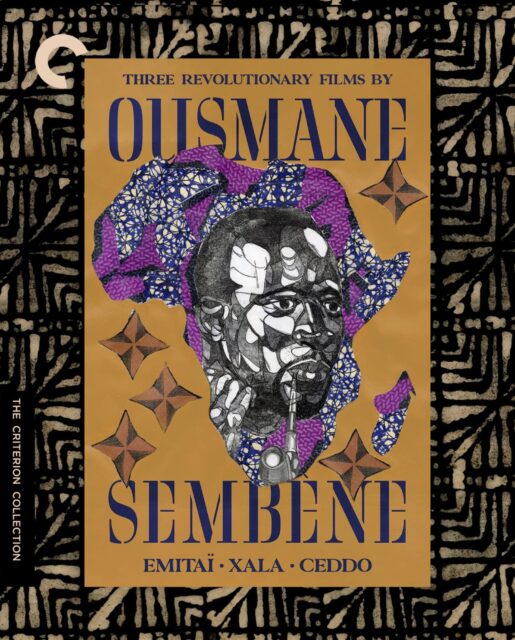
The post Home Video Hovel: Three Revolutionary Films by Ousmane Sembène, by Scott Nye appeared first on Battleship Pretension.
I’m going to cheat a bit and start this piece off with the same quote that Yasmina Price uses to begin her excellent essay, included with this new release – when asked about the concern that his films might not be legible to a European audience, writer/director Ousmane Sembène replied, “Why be a sunflower and turn toward the sun? I myself am the sun.” First takeaway – interviews used to go a little harder. Second takeaway, having just watched the three films in Criterion’s new release, Three Revolutionary Films by Ousmane Sembène – I am not alone in struggling to quite comprehend some of them.
Not that it was exactly a problem to begin with, but one becomes self-conscious about these things, particularly with films from underrepresented cultures and regions. The relief, however, is that amidst their specific purchase in the politics, culture, and history of Senegal, each of these three films – 1971’s Emitai, 1975’s Xala, and 1977’s Ceddo – is arresting, strange, inventive, and just this side of surreal. In Price’s essay, she makes reference to Sembène’s reputation as a social realist in contrast to fellow Senegalese director Djibril Diop Mambéty (Touki Bouki), and while I definitely understood that previously, having only seen Black Girl, these three films carry with them an air of remove from the natural world, as though each is taking place on a stage, each character a representation, not always of an idea or of a moral, but of an aesthetic of how people present themselves and behave.
Emitai comes closest to the realist charge (if indeed that could be a charge at all). Chronicling a 1942 resistance movement lead by women in the Diola village against the French government that conscripted them into its army (and stole their rice, to really drive the knife in), the film is brutally confrontational about not only a moment in time – it would be easy to assign all blame to the Vichy government that formed after Germany assumed control of France in the midst of World War II – but as a continuation of decades of colonial control by the French. The grievances the villagers note run much further into the past than a few years ago. Yet, still, even amidst this reclamation of Senegal’s history for the Senegalese, what’s most immediately striking are the voices, the poses, the deferential rigidity of the African men who have become completely subsumed by the army contrasted with the expressive freedom of the villagers resisting similar sublimation. The potential simplicity of this depiction is further contrasted with the singular sense of purpose within the French army against the divisions and uncertainty of direction within the villagers; freedom comes with options, sometimes too many to mount effective change.
Colonial influence remains a crushing force in the next two films, but more and more Sembène’s political concerns will turn inward, addressing the discord amongst Africans and the unease with which people of wildly disparate belief systems live in such close contact. Xala is certainly the funniest and most outlandish film in the set, the most approachable, and – probably not coincidentally on either front – the most modern. Adapted from Sembène’s own 1973 novel (he was a published author ten years before becoming a filmmaker), it depicts a rich Senegalese businessman who, upon marriage to his third wife, is struck impotent. He quickly suspects one or both of his other wives put a curse on him – they make hilariously clear in the lead-up to the wedding that they’re displeased he’s marrying again at all – and spends weeks privately humiliating himself before a series of shamans who promise to lift it, for a price of course. All the African traditions have now become commodified, and El Hadji’s singular-minded pursuit of his own libido sees him diminish not only himself, but his business and finances along with it. This metaphor for a useless and limp upper class, imitating the Western style of dress and manner they had supposedly worked to free themselves from, is far from subtle. Particularly by the end, which at once expands its spiritual connotations while also grounding it quite firmly in the daily misery that figures like El Hadji inflict on the people around them, Sembène isn’t concern with subtlety; he’s taking too much pleasure in tightening the screws.
Xala was, understandably, a pretty big success – it’s a raucous crowdpleaser that lets us laugh at a rich guy, what’s not to love – and gave Sembène some clout to make a particularly adventurous piece with Ceddo. Women have curious positions in each of these films, more background drivers of their stories than the chief subjects of them. They lead the resistance in Emitai, though are rarely the driving forces of a scene; in Xala, El Hadji’s wives dictate the course of each scene their in, but remain productively at a distance, their influence on him palpable on a visceral, spiritual, and emotional level, as though with each marriage he’s attempting to create something more in line with his misogynist fantasy, yet only complicating his own misery.
Ceddo sets up the expectation that women will be more acted upon than ever, only to upend that assumption first through aesthetic presentation and finally through narrative domination. In his most abstract setting, sometime in the eighteenth or nineteenth century when Europeans have infiltrated Africa but not yet established formal colonial administration, a small band of Ceddo (outsiders, as the film’s title is sometimes translated) try to retain traditional culture amidst rising Muslim and Christian factions, to say nothing of the slave trade as well. When their king suddenly sides with the Muslims, they kidnap his daughter, Dior Yacine. Portrayed by Tabara Ndiaye, she is immediately striking, not only for her beauty, but for the ease and confidence with which she moves through this chaotic world. She seems not overly concerned with her kidnapping, as though she already sees the other side of this conflict, her eventual role in its proceedings, and possibly even the potential future of Africa as well, beyond even the time in which the film was made. She is a utopic figure in discordant times. I spent too much time in this film trying to parse the various factions and allegiances, which the film is persistently pointing towards her, standing slightly outside of it, slightly above it, yet driving home a lesson that’s beyond instruction, a sense that just as individuals must choose their own fate, so too must a nation, and potentially a continent.
All three films are transferred to Blu-ray (a DVD edition is also available) from new 4K masters restored from the original camera negatives by Eclair Classics in Paris. They look really spectacular, with vibrant colors, terrific density and detail, and thick, but hardly obtrusive, grain. Ceddo shows a bit more wear than the others, but as I’ve written in these columns before, I want these transfers to remind me of the experience of watching a film print. Those sections, which I should also note are quite few, still retain terrific integrity and warmth. There’s no fade to the colors, which have to be clear and powerful but not overly saturated and they totally hit the mark. The films look as great as any Blu-ray release I’ve seen this year.
Aside from the Price essay, the set only includes two supplements – a half-hour 1981 documentary chronicling the production of Ceddo and a new conversation between Mahen Bonetti, founder and executive director of the African Film Festival, and writer Amy Sall. The documentary is an odd mix of very reverential towards Sembène and totally willing to include a brief interview with his wife who admits it’s kind of a pain to be married to someone who will put his art before his family when he feels he needs to. The forty-minute Bonetti/Sall conversation is really stellar, very dense in detail and insight into Sembène’s career, the history of Africa, and how the two intersect. At the drop of a hat they might bring up the history of rice in the region or the broad scope of gender politics in the 1970s, as well as Bonetti’s personal recollections of knowing Sembène. They talk a lot about the visceral appeal of his films as well, and what first captivated them.
Though some of their recent multi-film director sets that only have a couple supplements have been relegated to stacking the discs in plastic Scanvo cases, Criterion gives Sembène the full cardboard treatment with individual mini-foldout cases for each film. It’s a beautifully-designed set with an aesthetic well suited to the films included.
Though sparse on supplements, what’s there is really informative, and the films themselves are so striking that it’s an easy recommendation to buy. Criterion has stepped up efforts in recent years to include more works by Black filmmakers and these restorations, produced for Sembène’s centennial, provide the perfect avenue to continue discovering his work.
The post Home Video Hovel: Three Revolutionary Films by Ousmane Sembène, by Scott Nye first appeared on Battleship Pretension.
The post Home Video Hovel: Three Revolutionary Films by Ousmane Sembène, by Scott Nye appeared first on Battleship Pretension.
